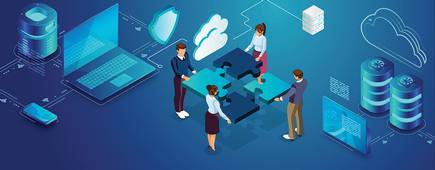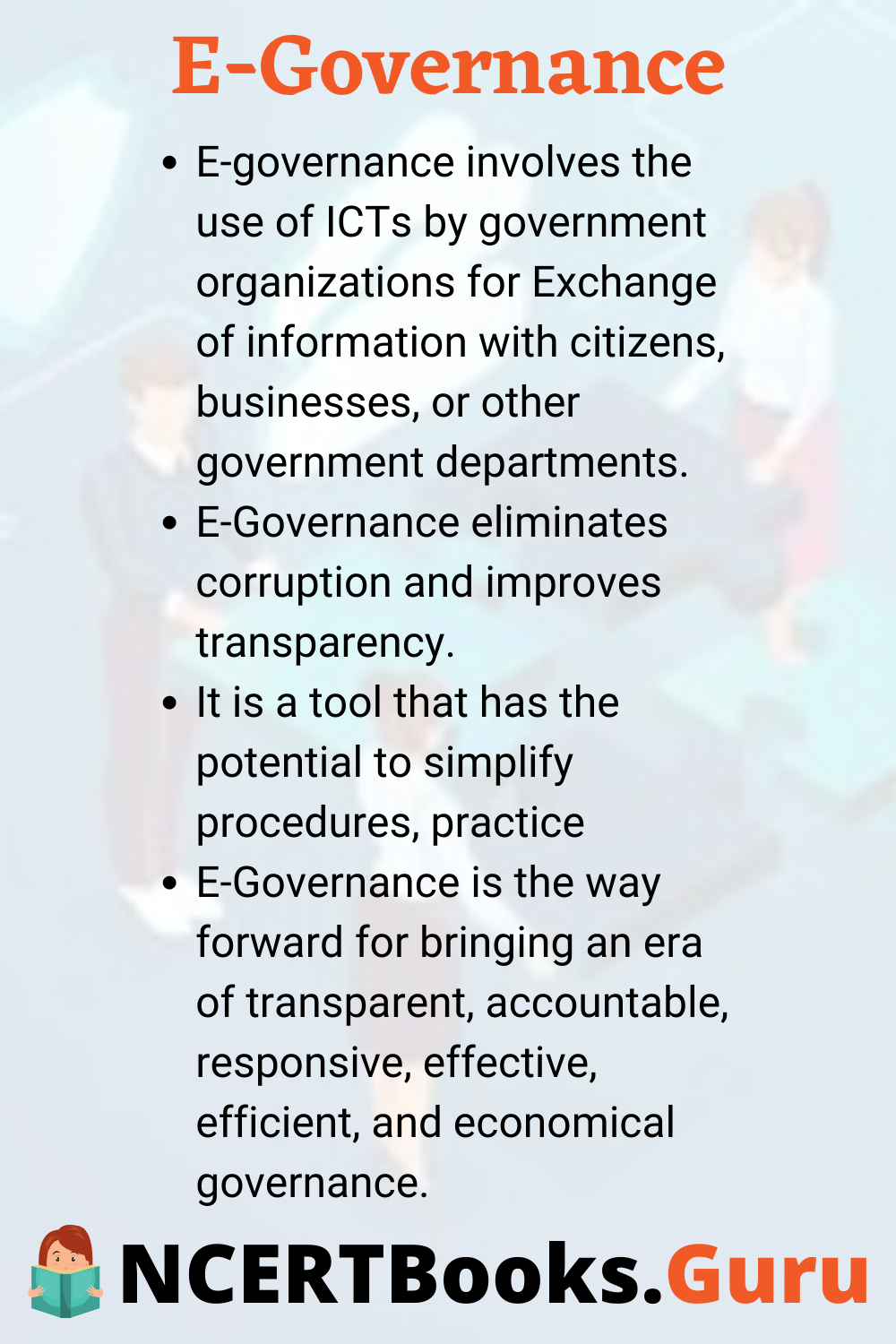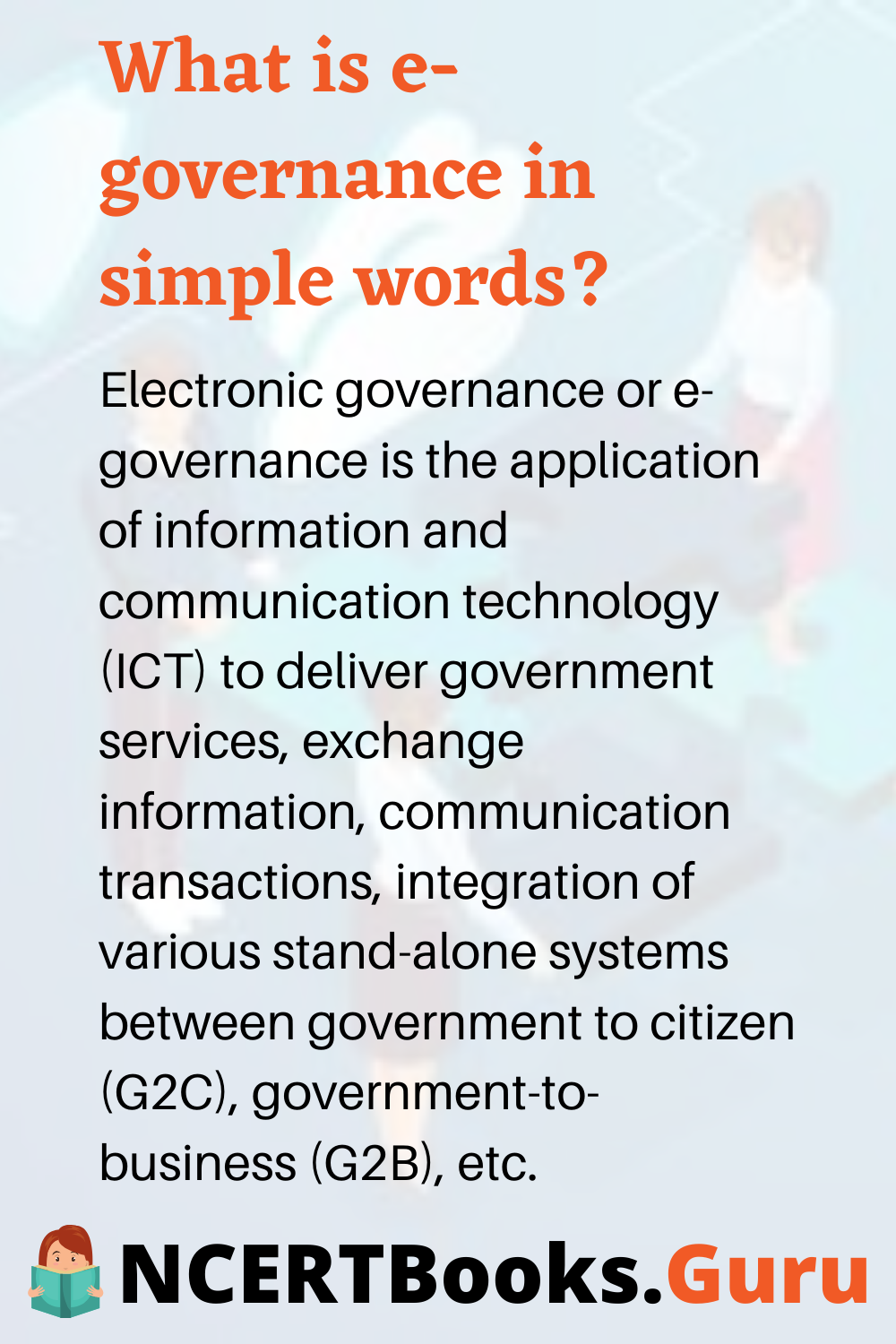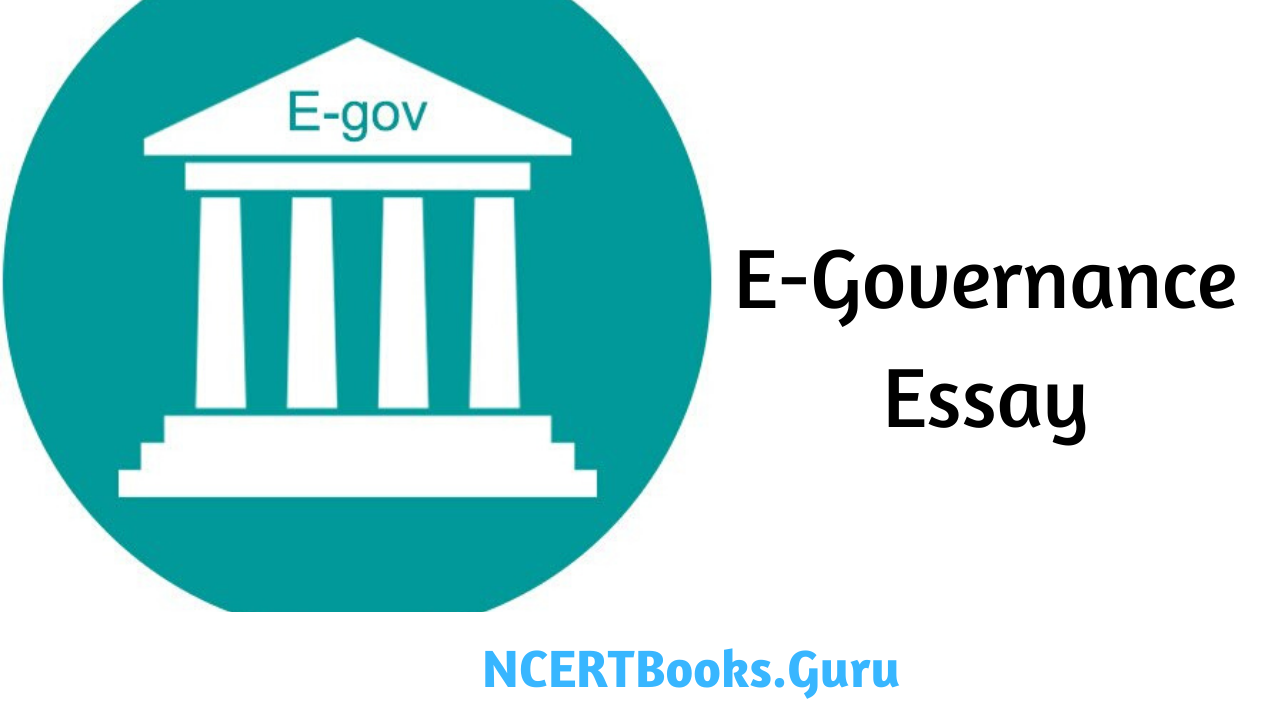E-Governance Essay: Ever wondered what if the spark generated by striking flint stones had not triggered a series of cascading thoughts in the minds of the early man? What if the rolling ability of the wheel had failed to charge his grey cells? If wheel and fire were not put to the application, the utility of these tools would have remained inert and evolution story might have taken a different turn altogether. In the application of tools, borne out of human craft and intelligence, lies the key for the continuous process of growth and progress.
New paradigms open up with unimagined prospects with the process of adapting to newer tools. Inventions can justify their utility for mankind by unfolding the ease with which they mingle into human lives to simplify lifestyles. With information & communication technology displaying a wide foray of opportunities, their integration in different aspects of governance is the path to welcome the future.
- Long Essay on E-Governance 500 Words in English
- Short Essay on E-Governance 200 Words in English
- 10 Lines on E-Governance
- What is e-governance in simple words?
- What are the objectives of e-governance?
- Why e-governance is needed?
Long and Short Essays on E-Governance for Students and Kids in English
Given below is a Long essay on E-Governance of 400-500 words and is suitable for the students of Classes 7, 8, 9, and 10 and a short essay of nearly 100-150 words for the students of Classes 1, 2, 3, 4, 5, and 6.

Long Essay on E-Governance 500 Words in English
E-Governance Essay is usually given to classes 7, 8, 9, and 10.
The reach and richness of governance is a major determinant of quality of life enjoyed by the citizens. Over the years, the domain of governance has expanded manifold and governments globally- with different levels of embrace to the private sector participation have been striving to satisfy all needs of the citizens.
The need for evolving into a stratosphere of efficient, economic, and effective governance stems from an increasingly demanding and aware civil society globally. The information revolution made possible by the small tool of ICT has educated people of their rights and dues. The vociferous demands for good governance can no longer be muted. It broke out in form of Arab spring this year or closer home as various anti-graft agitations. It is the quality of services, along with their unmistakable delivery, which has grabbed the attention of the civil society.
The reason the de-attier of governance is to provide opportunities to maximize the growth of human potential. The enabling spirit must inherently emanate from the core of any governance. It carries immense trust and expectations of the masses and must imbibe all ‘goodness’ for its’ longevity. The path for the dawn of good governance has been simplified by tools presented by advancements in Information and Communication Technology. The adaptation of these tools in different domains of governance has the potential to unleash an era of e-governance. With varying degrees of progress, nations across the globe have progressed on absorbing the tools of ICT to make their governance economic, efficient, and effective.
Simplification of processes and ease of storage, transmission, and retrieval of information lie at the heart of the transformative process of governance using ICT. Web-enabled service delivers)”, the advanced tip of the finger communication facilities and increasing ease in handling large volumes of data have found a varying utility to bring smiles on millions of faces.
e-governance brings governance to the doorsteps of the individual. With an ingrained tenet of non-discrimination, it manages to drive systems to provide an equitous environment. The gulfs of class, color, language, region or religion fail to impede the service delivery. Every citizen who meets the defined norms and criterion stands eligible to receive benefits, escaping the judgmental prejudices linked with human involvement.

Another prospect that can mark its presence in governance with increasing absorption of ICT is accessibility. Several inhibitions cloud the mind space of individuals while approaching any government office. Often improper knowledge about nuances of schemes or eligibility criteria or procedural requirements prevents a person from approaching the facility provided by the policy. The maze of counters and desks induce a high degree of repulsion, esp. in population from rural or disadvantaged backgrounds. The implementation efficiency of the policy gains a boost by the ease of its access through tools of e-governance in the form of interactive screens in enabling kiosks.
With a wider diffusion of e-governance, daily labor will not have to forgo his wage for one day for an unsuccessful trip to the revenue office. On the other end of the spectrum, a multimillionaire will be facilitated through an informational portal for avenues of investment. He can browse opportunities, transfer amounts online, and obtain single-window clearances for his project without encountering hassles of red-tapism.
Government transactions have been marked by veils of secrecy. The winds of change have begun by the RTI legislation. They are bound to intensify with the adoption of e-governance at different levels of stakeholders’ interface with the system. With computerization creeping in at all levels of governance, file movement tracking can become simpler and accountability ascertained. Deadlines, for clearance or decision making, can be accurately monitored by the complainant himself through web-enabled access.
An era of e-governance will help in curbing the generation of black money and the emergence of a parallel economy. As the interface between the service provider and the consumer becomes electronic in nature, the discretion of individuals will be diminished and activities of middlemen removed from the chain. Citizens will be entitled to obtain value for their money. With their actions under an electronic scanner, transparency will stifle out corruption and drive in professionalism in the manner of operation of government officials. This will have a direct impact on the efficiency and effectiveness of the systems with increasing productivity contributing to a healthier economy.
With the proliferation of banking and e-transaction facilities, leakages from the government schemes can be plugged. Smart cards that enabled cash transfer directly to the account of the worker will widen and strengthen the social security net. Tools of e-governance can revolutionize the efficacy of already prevalent government schemes. Benchmarks of efficiency using e-governance in PDS have been set by the Chattisgarh Government. Success stories of cash transfer in NREGA have also highlighted the enormous potential held by e-governance.
Along with strengthening, financial inclusion, and lifting the masses above the poverty line, e-governance provides the perfect solution for the dissemination of information. Village resource centers have become a reality, advising farmers about the suitable crop, cropping pattern, fertilizers and pesticides to be used. Experts from different regions can collaborate their rich experiences cutting down the barriers of geographical distances and enrich the poor and needy with timely advice. Similarly, health services have received a major boost with constraints of inaccessibility and poverty failing to be an impediment in getting world-class treatment. Webcams and teleconferencing tools have shrunk the distances and brought patients closer to their saviors.
Another arena of good governance is delivery of value in the form of education, e-governance steps in to connect universities and facilitate seamless exchange of information, e-governance can soon help in making the knowledge society a reality. Students sitting in different corners of this nation benefit simultaneously as they attend to nuances of nanotechnology or molecular kinematics from the experts, sitting in their comfort.
e-governance has the potential to transfer the entire culture of governing and those governed. It expands the horizon of opportunities available for any citizen cutting across narrow barriers of caste, color, language, or religion. It furthers the noble ambitions of the framers of our constitution by facilitating the spirit of fundamental rights and directive principles of state policy. The tools of e-governance add dignity to the lives of individuals- the poor, marginalized, and struggling with some or other deficit afflicting their lives.
e-governance will also bring about an environment-friendly ecological governance framework which will reduce the huge amount of paper requirement to carry out the government proceedings. It will, thereby, contribute to the nurturing of a greener and cleaner planet.
As the largest employer of masses, the government machinery ensures livelihood for millions at different levels. With the different amounts of skills required to carry out their duties, several employees lack in even the elementary knowledge of computers. To unfold an era of e-governance, a massive training program carried with the help of experts and universities a pre-requisite. Another implementation hazard is the infrastructural sufficiency desired to promote the tools of e-governance in every nook and corner of the nation. An interconnected network of communicating devices at block, district, state, and central levels with suitable timely upgrades will be essential as the backbone of the e-governance paradigm. Sufficient speed of processing and bandwidth for data transfer pose challenges for bringing about e-governance in full measure.
Another problem in the implementation of e-governance is in the form of safety and security of huge amounts of data involved. Any government department caters to the needs of millions of citizens and thereby has to deal with a substantial amount of data- much of which may be confidential in nature. Hacking and data piracy need to be guarded against by taking suitable preventive measures. These have to be dynamic and must evolve continuously to tackle the evil designs of hackers. The NIC will have to be equipped to emerge as the hub of proficiency to ensure data safety. Firewalls and latest anti-virus updates must be developed and made available at all centers.
With a huge linguistic diversity within the stretch of the nation, blanket software dissemination may fail to yield results at the grassroots. Entrepreneurship must be promoted vigorously to come up with vernacular solutions for the interactive features of e-governance equipment. Rural India will benefit from the technology only when it is redesigned to their comfort levels. More emphasis on sight and sound features will enhance their utility for the millions still enveloped in the darkness of illiteracy.
Living in an era of uncertainties, e-governance presents risks in the form of survival of data. The problem stares in the form of a back-up requirement of data being handled electronically. Certain fields of sensitive nature may not be worth gambling upon and a backup paper record will have to be kept till adequate reliability and faith are generated about the handling of data.
The transformation from a paper and file-based governance to an electronically advanced is a journey every nation undertakes. Preparedness is a continuous process of refinement of available technology, its’ customization, absorption in government systems, and societies’ preparation to utilize it with ease. At our stage of the journey, we still encounter slow servers, irregular data download speeds, incidents of phishing, hacking and frauds, and regular unsatisfactory grudges finked to e-banking and e-commerce. These and several other irregularities still need ironing. The awareness about features if the IT Act amongst the public and also among the law enforcement agencies must be increased. Simultaneously, the provisions of this Act must be periodically reviewed and strengthened to meet the emerging challenges.
The biggest impediment, however, stems from the human element. The lack of will to adapt and inertia to continue in the regime of secrecy and paperwork stall any progress to bring about all colors of e-governance. As a developing nation, battling with myriad unique problems, e-governance sounded a distant dream. However, steps have been taken on the path to materialize this dream. Railway ticketing and passport registration led by example to ensure hassle-free service to the citizens. Though some snags have been observed with server failure for tatkal booking, the railways need to rise to the occasion and display its’ commitment of service through electronic means.
Similarly, the e-court program is another ambitious project which has the potential to change the face of the judicial system of the nation. As a critical component of governance, the judiciary is overburdened and delays plague the delivery of justice. The e-court project will link the courts and facilitate the sharing of judgments, the transmission of data, and tracking the status of the cases.
A similar movement is brewing with the CCTNS in the police department – a wing responsible for maintaining law and order by active crime prevention and detection. Linking of police stations with HQ_and beats, real-time monitoring of criminal activities, electronic data, and fingerprint recording and sharing can go a long way in developing an efficient and proactive policing unit, which inspires confidence and faith in public. The NeGP is yet another drive to smoothen the movement of files across departments.
Students can find more English Essay Writing Topics, Ideas, Easy Tips to Write Essay Writing, and many more.
Short Essay on E-Governance 200 Words in English
E-Governance Essay is usually given to classes 1, 2, 3, 4, 5, and 6.
Revenue departments have also displayed flair in facilitating the assessee by employing e-tools for filing of registration and returns. Similar efforts by several states in land registration can go a long way in solving major disputes in the rural heartland of the nation. In a different field, the introduction of elements of computerization has helped in easing and simplifying processes and improving service delivery to the stakeholders, e-governance measures in offices help in streamlining complex procedures, enhancing efficiency, and cutting down the red-tapism linked delays.
The application of e-governance is still in the nascent stages in the developing Indian society and the limitless possibilities it has in its fold are tough to even imagine. As its introduction will strike on the selfish interests of several groups, there are big lobbies resisting its application in different governance-related programs and procedures.
The challenge for government and bureaucracy lies in driving its percolation to the grassroots, in spite of such resistance. e-Governance is the way forward for bringing an era of transparent, accountable, responsive, effective, efficient, and economical governance. It is a tool that has the potential to simplify procedures, practices, and alter service delivery in a radical manner. There is nothing that can deny its’ arrival on the scene. The pace of its adoption will soon become a determining factor in the anointment of our nation as a global superpower.
10 Lines on E-Governance
- Good governance is the efficient functioning of public institutions for developmental and welfare programs.
- E-Governance eliminates corruption and improves transparency.
- Government transparency is important because it allows the public to be informed about what the government is working on along with the policies they are trying to implement.
- E-governance involves the use of ICTs by government organizations for Exchange of information with citizens, businesses, or other government departments.
- It also ensures that the benefit reaches to the lowest section of society.
- It needs the participation of each section of society in the socio-political decision.
- The ultimate goal of e-governance is to enhance the interaction between three main actors in society—government, citizens, and business.
- E-Governance is the way forward for bringing an era of transparent, accountable, responsive, effective, efficient, and economical governance.
- It is a tool that has the potential to simplify procedures, practices, and alter service delivery in a radical manner.
- The pace of its adoption will soon become a determining factor in the anointment of our nation as a global superpower.

FAQs on E-Governance?
1. What is e-governance in simple words?
Electronic governance or e-governance is the application of information and communication technology (ICT) to deliver government services, exchange information, communication transactions, integration of various stand-alone systems between government to citizen (G2C), government-to-business (G2B), etc.
2. What are the objectives of e-governance?
Ultimately, the goal of e-government is to enhance the interaction between three main actors in society—government, citizens, and business thereby to promote political, social, and economic progress in the country.
3. Why e-governance is needed?
Government transparency is important because it allows the public to be informed about what the government is working on along with the policies they are trying to implement.
J.C. Bose Summary
